I have often seen references to “Irene Castle Corticelli” in my research for Recollections blog posts but didn’t know much about the woman behind the brand. I love studying the lives of women related to the fashion industry of the 1910s and 1920s so have had her on my list for a while. I was surprised to see even more surviving photographs of her than there are of Edwardian fashion icon Camille Crawford and knew there was a great story to tell.
Irene Castle lived a life of art, grace, and beauty; being known for years as “the best-dressed woman in America.” If nothing else, you will love the stunning black and white images of this Flapper icon. Here is a short look at her fashion impact.

Claim to fame – the dancing duo

The world first came to know Irene Castle as Mrs. Vernon Castle, part of the dancing duo that would bring the modern dance movement to the mainstream.
Both amateur performers at the time, the two met in 1910 in New York and found themselves to be a perfect match. They married a year later with love and a commitment to perform together and embrace a life of dancing and encouraging others to do the same. They enjoyed a short tour in Paris in 1911 before returning to New York and becoming regulars in the vaudeville scene and then quickly found their way to the silver screen and Broadway.
What I really love about this power couple is that they saw the mental and physical benefits of dance and wanted others to find the same joy. They opened a dance school called Castle House together, ran a nightclub/restaurant (with plenty of live music and performances), taught private lessons (going for as high as $1,000 a pop), and in 1914 co-authored the book Modern Dancing.
Both were passionate and sure about the many benefits of dance. One of my favorite quotes from Modern Dancing reads:
“Every night and every morning, with the faith and hope of religious zealots, thousands of women bob up and down, and squat and rise, and bow and bend and wiggle their heads, and rub their necks, and go through all the rites of the liturgy of beauty — that is, if they don’t dance. The woman who dances does not need other beauty aids; beauty will seek her. That is not a theory, but a fact; for when a woman is dancing she is happily unconscious, and therefore easily carrying out all the exercises taught by beauty expert.”
Tragically, the love story was cut short. In 1918 Vernon died in a plane crash during a training mission for his WWI service. His gravesite includes a sculpture of Irene weeping.

Trendsetter
Irene was grief-stricken when Vernon passed and found it too painful to continue ballroom dancing. She would continue to perform, however, and became one of the most famous film stars of her time.
The world was already fascinated with Irene Castle before she hit the big screen and the shift to film allowed her to become a household name and for huge numbers of people to see her graceful, striking presence. Plus, it put her in front of the camera a lot more and the world got to see her impeccable taste.
You can see from the wording of the advertisements that Irene was considered to be one of the most glamorous women in Hollywood. She was featured in many photographs in the 1917 book Woman as Decoration, which explored how women can and should present themselves in public in the highest standards of femininity of the time. Author Emily Burbank said of her choice of model:
“Mrs. Vernon Castle who set today’s fashion in outline of costume and short hair for the young woman of America. For this reason and because Mrs. Castle has form to a superlative degree (correct carriage of the body) and the clothes sense (knowledge of what she can wear and how to wear it) we have selected her to illustrate several types of costumes, characteristic of 1916 and 1917.”
Newspaper and magazine articles from the time regularly report on Irene as “the best-dressed woman in America,” including the brochure for her clothing company, seen below, that it was a reputation that was widely known.

Castle band
Whether Irene cut her hair to make it easy to manage after an appendix surgery or because it was the hottest style of the time is up for debate (according to me). Whatever the case, one of the styles she was best known for is that of the bob held in place with a decorative band. It makes perfect sense as it would keep the hair still while dancing and still allow for the loose, short styles of the time.
I still see this headband referred to as a “Castle band” today.
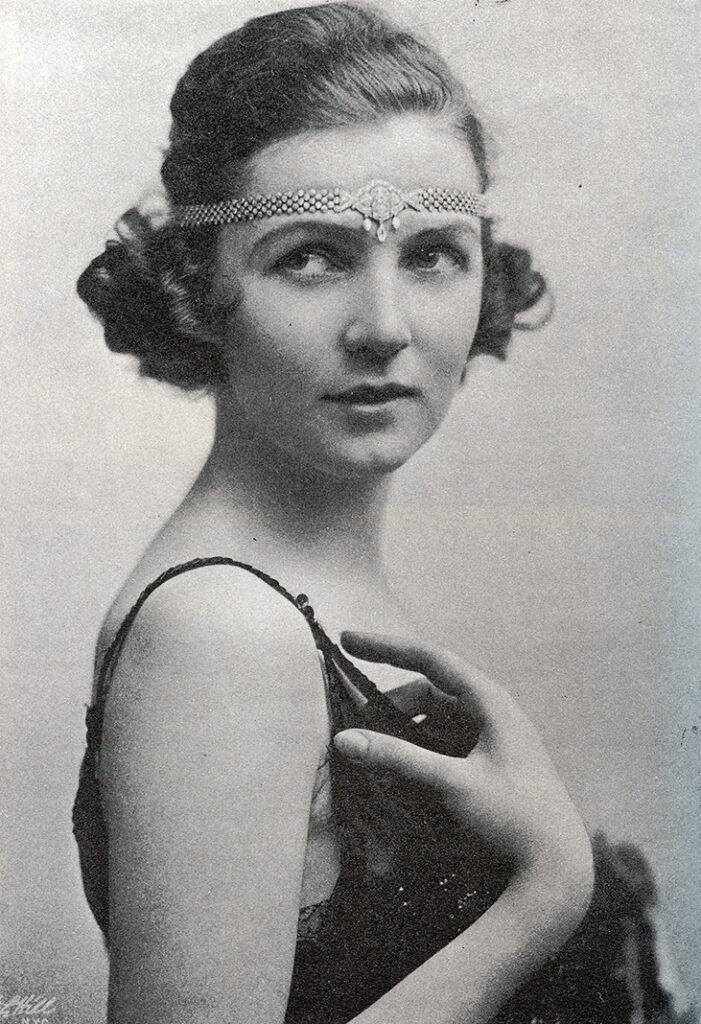
Castle hat
Irene enjoyed wearing a cap that is so idyllically 1920s to us today. It was a cap worn close over the head with “wired, stand away points” on each side. While Irene did not create the style and I don’t believe her soon-to-be clothing line manufactured it (correct me if I’m wrong!), because she was such a fan of the new look it became known as the “Castle cap.” As you can see from this delightful example from FIDM Museum, the name has lasted persisted.
Irene was a personal branding expert that people still talking about today. I have read that she may have been the one to name both the headband and that hat after herself.

Castle Clothing
And talk about trends, Irene Castle is believed to have been the first film star to partner with a fashion label to create branded looks. In 1923 she created ??Irene Castle Corticelli Fashions with silk manufacturer Corticelli. Their first venture was designing “Patria” themed fabrics. From there a line of clothing based on Irene’s favorite outfits was created, along with new designs she collaborated with the silk company on.
You can see from the brochure for Corticelli below that it was well known how highly regarded her fashion sense was and how widespread the opinion was that she was Hollywood’s best dressed.


Fashion reformer
Like many female performers and athletes of the time, Irene was a champion for the new, less physically restrictive clothing styles that were gaining popularity in the Edwardian era. This makes sense. It’s hard to imagine a ballroom dancer wearing a hobble skirt or boned corset!
Fashion reform was a topic the Castles covered at length in Modern Dancing. Irene didn’t hold back in expressing her belief that fashion needed to permanently change to accommodate women’s physical activity. Chapter four is titled “Modern Dance as Fashion Reformers” and opens with an admonition of previously oppressive fashions:
“On looking back a few seasons to the clothing worn by women and girls, you will recall long, cruel corsets and garters that trussed them like fowls for the roasting. You will remember, too, the tight snakiness of the hobble skirt and the hats that were shaped like peach-baskets.
All women will recall them because all wore them, and all wore tight shoes and heavy petticoats and high, stiff-boned collars. Then Paris began to dance…”
Irene was no fan of the corset. She would also write:
“All the old long, stiff tube corsets are left on the bargain – counters. Nor has this reform stopped with the abolition of the corset, for it is to be noted that the modern shoes are big enough to dance in and are held in place with ribbons. The modern frocks are collarless, and the skirts are subtly cut so that they fall freely and give the perfect ease one must have to dance the modern dances.”
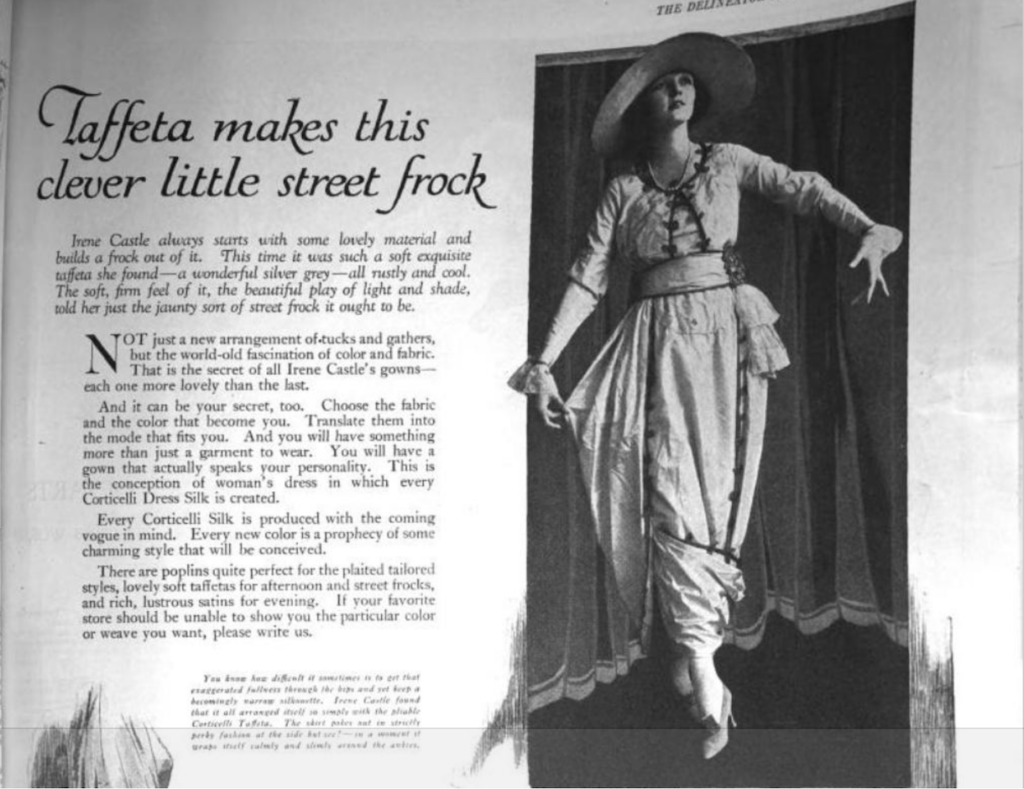
Perhaps because it was the lens from which she viewed the world, but Irene seems to have been convinced that it was due to the modern dance movement that fashion had changed so drastically since the turn of the century. Besides making boned corsets, collars, and uncomfortable shoes obsolete, she also credited the movement for making short and simple hair more fashionable, increasing the popularity of bloomers and short petticoats, and doing away with long trains, large hats, uncomfortable garters, and heavy fabrics. Another passage reads:
“Dancing has had its influence upon the materials that have come into vogue. It is necessary to have one’s frocks soft and light….Perhaps the designers and the manufacturers will not admit hat the dance is responsible for the vogue of these fabrics. But we all know that the demand makes the supply, and the demand of the women who dance is, “Give me something soft and light.”
Designers may have been slow to recognize the dance movement as being responsible for changes in styles during the time and I’d probably be on their side with things. While many blog posts about Irene Castle will also credit her for the popularity of the popular fashions of the time, they had in fact already started to become mainstream before she became so famous and her fashion choices were seen as impeccable, not radical.
That being said, I am thankful she made the choices she did, as it resulted in beautiful images that we can still enjoy today.

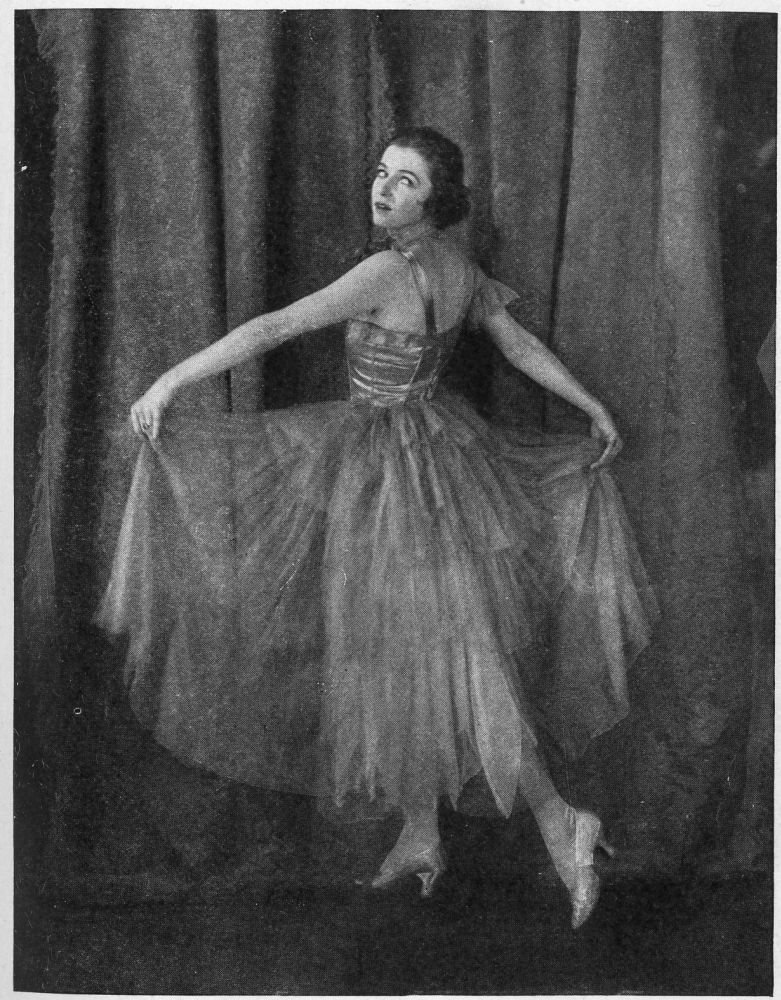
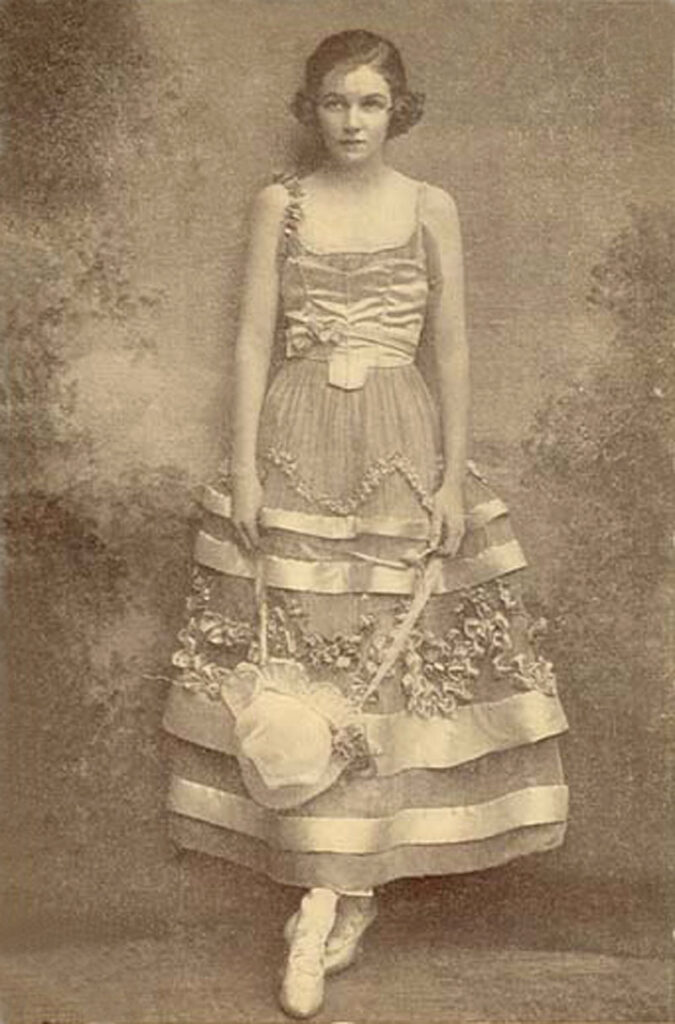
More about female fashion icons from the past:
Ellen Demorest: Victorian fashion icon



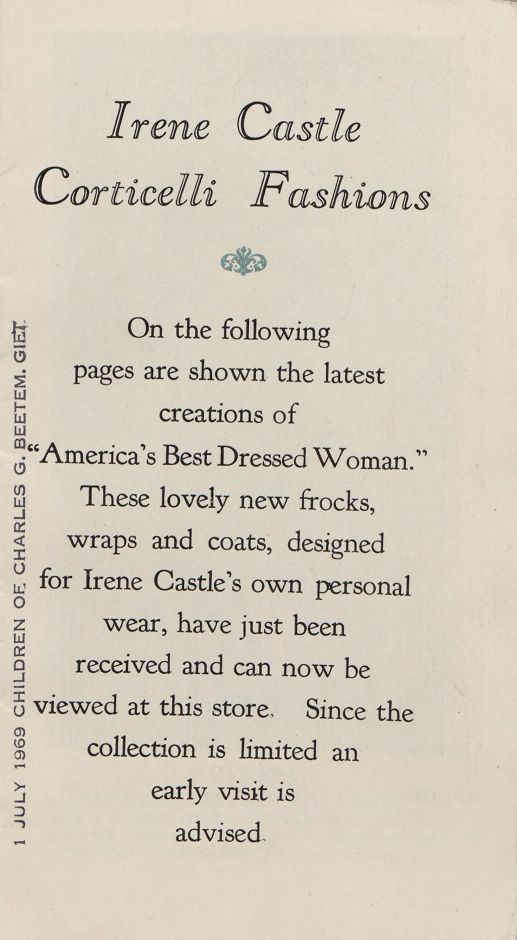












What a wonderful article with so much info of someone we don’t hear much about. I was a professional dancer in my 20’s so her name was familiar to me. I’m attempting to make a film set in 1928 at the Lumina Ballroom in NC and will hope to bring this fashion you love so much to the forefront because there will be lots of dancing in the film. Maybe we can connect more via email. Thnx again for sharing such a creative era!!
Love all your posts! I’m a button collector and love seeing buttons on the old dresses, etc. Your descriptions are spot on, and I’ll be slowly reading each article you’ve posted!
Keep up your fabulous posts! We love them!!